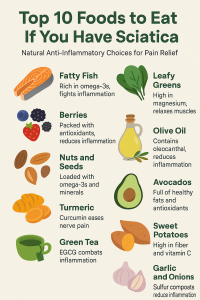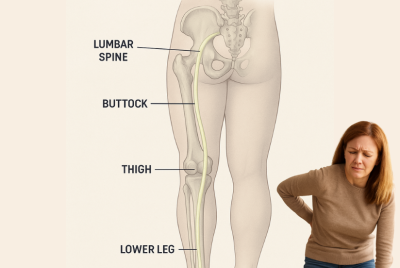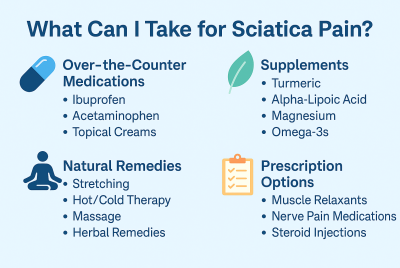Top 10 Foods to Eat If You Have Sciatica: Natural Anti-Inflammatory Choices for Pain Relief
How Your Diet Affects Sciatica Pain
If you’re struggling with sciatica pain — that burning, shooting sensation running from your lower back down your leg — you know it can impact everything from walking to sleeping. While stretches, posture, and physical therapy are key to recovery, many people overlook one powerful tool for natural relief: nutrition. Certain foods can reduce inflammation, support nerve repair, and improve circulation, all of which help relieve sciatic nerve pain over time. On the other hand, processed foods, sugar, and refined oils can make inflammation worse. This article breaks down the top 10 foods to eat if you have sciatica, plus practical diet tips, meal ideas, and what to avoid if you want to heal faster.
Why Diet Matters for Sciatica Relief
Sciatica is often caused by pressure or inflammation around the sciatic nerve — the longest nerve in your body. When inflammation builds up due to poor diet, stress, or lack of movement, pain signals intensify.
An anti-inflammatory diet works by reducing oxidative stress and improving tissue healing, giving your body the nutrients it needs to recover. Over time, this can help:
-
Decrease inflammation and swelling
-
Improve spinal disc and nerve health
-
Strengthen muscles that support the lower back
-
Boost energy and reduce pain flare-ups
🥦 Top 10 Foods to Eat If You Have Sciatica
1. Fatty Fish (Salmon, Mackerel, Sardines)
Rich in omega-3 fatty acids, these fish fight inflammation at a cellular level. Omega-3s help reduce joint and nerve swelling, easing sciatic pain naturally.
Tip: Enjoy grilled salmon twice a week or add canned sardines to a salad.
2. Leafy Greens (Spinach, Kale, Swiss Chard)
Leafy greens are packed with magnesium, vitamin K, and antioxidants that calm the nervous system and relax tense muscles. Magnesium also helps prevent muscle spasms that can trigger sciatic pain.
Tip: Add spinach to smoothies or sauté kale with olive oil and garlic.
3. Berries (Blueberries, Strawberries, Blackberries)
These colorful fruits contain anthocyanins, powerful antioxidants that reduce inflammation and support nerve repair. They’re also low in sugar and high in fiber.
Tip: Eat a cup of mixed berries daily or blend them into a morning protein smoothie.
4. Nuts and Seeds (Walnuts, Chia, Flaxseeds)
Loaded with omega-3s and minerals like selenium and zinc, nuts and seeds help repair tissue and fight nerve damage. They also stabilize blood sugar levels, reducing inflammation triggers.
Tip: Sprinkle chia or flaxseeds on yogurt or oatmeal for a fiber boost.
5. Turmeric (with Black Pepper)
Turmeric’s active compound curcumin is one of nature’s most effective anti-inflammatory agents. Pairing it with black pepper enhances absorption by up to 2,000%.
Tip: Add turmeric to soups, curries, or a “golden milk” drink with almond milk and honey.
6. Olive Oil (Extra Virgin)
A staple of the Mediterranean diet, extra virgin olive oil contains oleocanthal, a compound that works similarly to ibuprofen in reducing inflammation — but naturally.
Tip: Use olive oil instead of butter for cooking or drizzle it on salads and veggies.
7. Avocados
Avocados are rich in healthy fats, vitamin E, and potassium, all essential for nerve function and joint health. They also support tissue repair and reduce oxidative stress.
Tip: Mash avocado on whole-grain toast or add slices to salads and tacos.
8. Sweet Potatoes
Packed with beta-carotene, vitamin C, and fiber, sweet potatoes provide antioxidants that protect your spinal and nerve tissue. Their complex carbs also keep energy levels stable throughout the day.
Tip: Roast sweet potato wedges or make a baked sweet potato topped with olive oil and herbs.
9. Green Tea
Green tea contains EGCG (epigallocatechin gallate), a powerful compound that reduces inflammation and protects nerve cells from damage.
Tip: Replace sugary sodas or coffee with two cups of green tea per day.
10. Garlic and Onions
Both are loaded with sulfur compounds that boost the body’s natural anti-inflammatory response and improve circulation — helping nutrients reach the sciatic nerve more efficiently.
Tip: Use garlic and onions daily in soups, sauces, and stir-fries for flavor and healing power.
⚠️ Foods to Avoid If You Have Sciatica
Certain foods can worsen inflammation and slow your recovery. Try to limit or eliminate:
-
❌ Processed meats (bacon, sausage, deli meats)
-
❌ Sugary foods and drinks (soda, pastries, candy)
-
❌ Refined carbs (white bread, white rice)
-
❌ Fried and fast foods
-
❌ Alcohol and excess caffeine
These foods promote inflammation, stiffness, and nerve irritation — exactly what you want to avoid when managing sciatica.
7 Foods To Improve Nerve Pain And 5 To Avoid
🥗 Sample One-Day Anti-Inflammatory Meal Plan for Sciatica Relief
Breakfast:
-
Oatmeal topped with blueberries, walnuts, and chia seeds
-
Green tea with lemon
Lunch:
-
Grilled salmon over spinach and quinoa
-
Olive oil and lemon dressing
Snack:
-
Sliced avocado with whole-grain crackers
-
Handful of almonds
Dinner:
-
Baked chicken breast with sweet potatoes and steamed broccoli
-
Turmeric tea or golden milk before bed
👉 This balanced meal plan supports nerve health, reduces inflammation, and keeps you energized throughout the day.
🧘 Lifestyle Tips to Boost the Benefits of a Sciatica Diet
Combining the right diet with daily movement and relaxation habits can enhance results:
-
Do gentle stretches (like knee-to-chest or child’s pose) every morning.
-
Stay hydrated — water keeps spinal discs healthy.
-
Maintain good posture at work and while sitting.
-
Walk daily to boost blood flow to the lower back.
-
Sleep on a supportive mattress to reduce nerve pressure.
Small, consistent actions add up to big improvements in pain management and mobility.
🩺 How Fast Can Diet Improve Sciatica?
While no food “cures” sciatica instantly, most people start noticing improvement in 2–4 weeks after reducing inflammatory foods and eating more nutrient-rich meals. Combined with stretching, chiropractic care, or physical therapy, dietary changes can make a noticeable difference in long-term relief.
FAQs About Foods to Eat If You Have Sciatica
1. What are the best foods for sciatica relief?
Fatty fish, leafy greens, berries, turmeric, and olive oil are some of the top foods that help reduce inflammation and support nerve health.
2. Can diet alone cure sciatica?
No, but it plays a major role in managing inflammation. Combine healthy eating with exercise, stretching, and medical guidance for the best results.
3. Is coffee bad for sciatica?
Too much caffeine may tighten muscles and irritate nerves. Limit to 1–2 cups per day and stay hydrated.
4. Can drinking water help with sciatica pain?
Yes. Proper hydration supports spinal discs and helps flush out inflammatory toxins that contribute to pain.
5. Are bananas good for sciatica?
Yes. Bananas contain potassium and magnesium, which help prevent muscle spasms and support nerve function.
6. Should I avoid dairy if I have sciatica?
Some people find relief by reducing their consumption of full-fat dairy products. Try alternatives like almond or oat milk if you’re sensitive to dairy.
7. How does sugar affect sciatica pain?
High sugar intake increases inflammation, which can worsen nerve irritation. Cutting back often helps reduce flare-ups.
Conclusion: Heal from the Inside Out
When managing sciatica, every small step matters. Alongside stretches and physical therapy, choosing the right foods to eat if you have sciatica can help reduce inflammation, nourish your nerves, and restore your quality of life.
Think of every meal as part of your healing process. With consistency, balance, and patience, you can feel noticeable improvement — naturally.
Disclaimer
This content is for informational purposes only and should not be used as medical advice. Always consult a healthcare professional before making dietary or exercise changes, especially if you have chronic pain or underlying medical conditions.

- Yoga Poses to Avoid with Sciatica
- Numbness in Foot from Sciatica
- Sciatica Relief Stretches for Beginners





